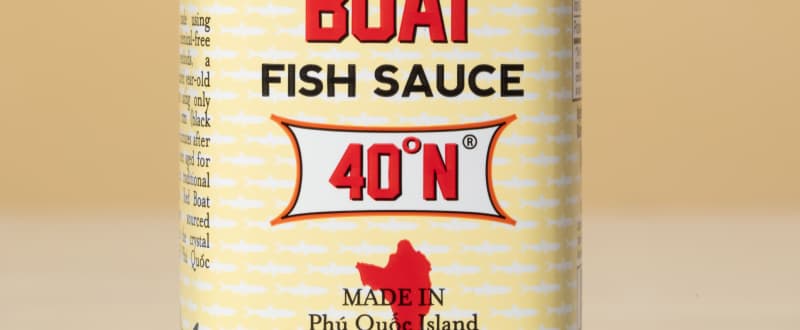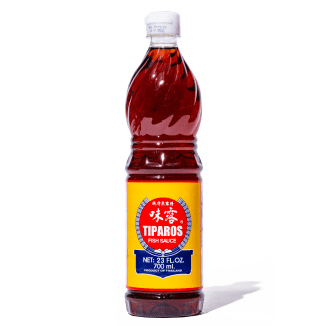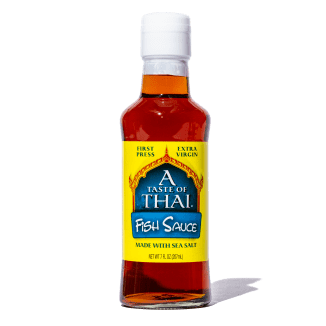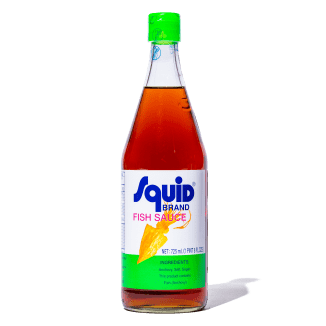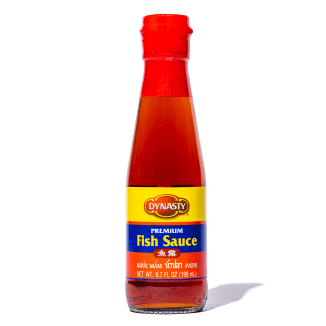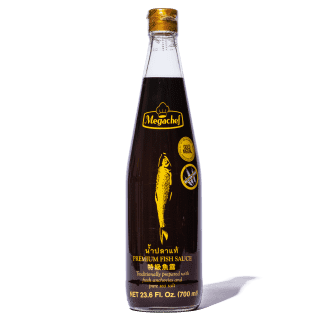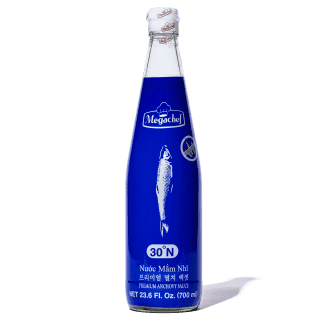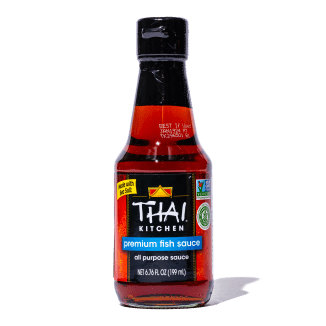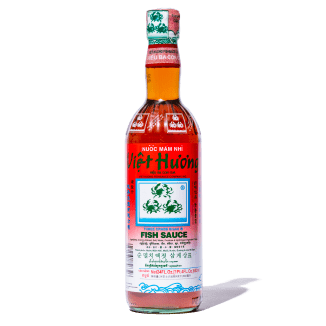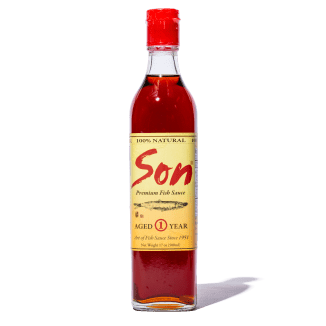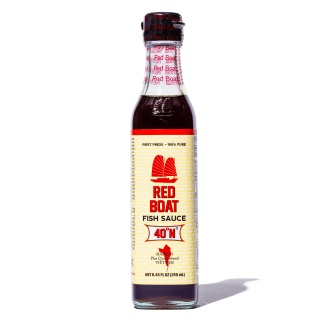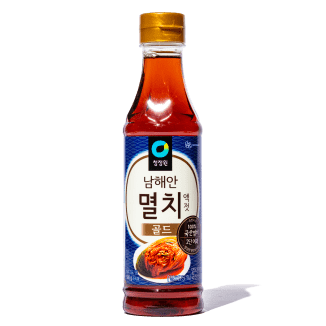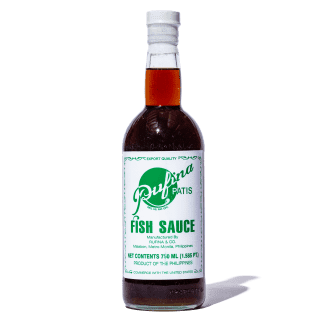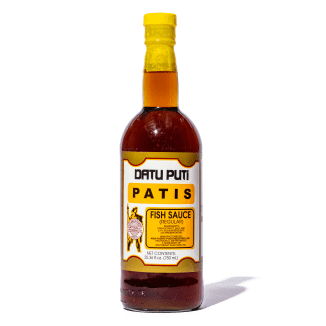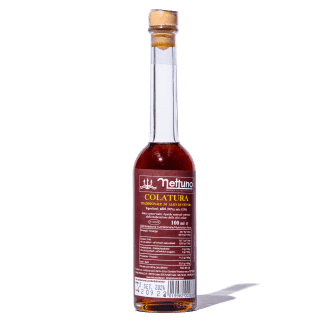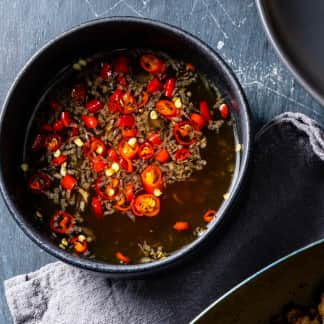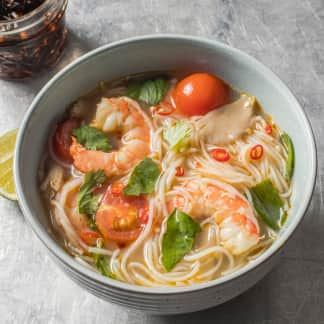Sweet, sour, salty, bitter, and umami are the five basic tastes, but taste is only one component of flavor. When considering a powerful ingredient like fish sauce, one can’t capture its entire personality without mentioning funk. Not a taste but rather a family of aromas, funk is often the result of fermentation, and its presence in fish sauce is no exception. Fish sauce is a crucial ingredient in Southeast Asian recipes, but its historical roots (we’re talking 5th century BCE) circumnavigate the globe. There are few other ingredients that can transform a dish with just a few drops, and a bottle (or two) of fish sauce deserves a place in every kitchen. Our tasting consisted of 17 sauces from seven countries, focusing primarily on Asian fish sauces, but including a few modern iterations of ancient European styles as well. We also interviewed experts well versed in a variety of cuisines to learn more about this potent seasoning.
Where Was Fish Sauce Invented?
It isn’t quite clear where fish sauce originated, but there’s one thing we’re sure of: It’s ancient. Its first recorded production, called gàros, was by ancient Greeks along the Black Sea. Many historians believe that garum, the Roman version, originated from gàros. In any waterfront locale—whether on the sea or fresh water—it’s highly likely that people were salting seafood to preserve it and thus discovered fish sauce independently.

What Is Fish Sauce and How Is It Made?
To make fish sauce, salted fish (typically anchovies, depending on the region and what’s abundant in nearby waters) are placed in containers (wood barrels, concrete vats, stone crocks, or plastic bins). They are weighed down to expel air and left to ferment, often in the sun or other warm environment, for six to 18 months or more.

During this time, the fish break down and release flavorful liquid. The enzymes performing this transformation come from two sources: the microorganisms responsible for fermentation and the intestines and muscles of the fish themselves through a process called autolysis, also known as self-digestion. Making fish sauce takes guts. Literally.
Fish sauce pierces your taste buds.
The first press of the liquid is the most flavorful and valuable, sometimes even referred to as extra-virgin fish sauce. Subsequent extractions are made by running seawater through the container, yielding a weaker product. Often, later extractions are mixed with earlier extractions to achieve the right concentration for the final product.
The World of Fish Sauce
After extensive research, we ultimately found that which sauce you should buy largely boils down to where you want to shop. Everything is available online these days, with ordering easier than ever before. Depending on the region, the average American supermarket only stocks one or maybe two brands of fish sauce, and they are typically made in Thailand. If you seek out an Asian supermarket, you will find a much wider selection (and most likely lower prices than those found online).

Many chefs and experts we spoke to use fish sauces from an array of countries. The sauces do vary from cuisine to cuisine, but unlike soy sauce, for example, they’re less specific in style. Generally, experts recommended keeping two types of fish sauce on hand: one higher-end, first-press product to use in raw applications such as salads and dips and one inexpensive, lower-grade sauce for cooked dishes such as soups and braises.
Vietnamese, Filipino, and Korean fish sauces tend to not have any added sugar and are thus less sweet. Thai fish sauces typically have added sugar and will contribute a bit more sweetness to dishes. We’ve listed the products we tried by cuisine, ordered from sweetest to least sweet, starting with Thai cuisine. We encourage you to try a few and see what you like, diving in at the cuisine you are most interested in cooking from and moving outward from there.
Thai Fish Sauce - Nam Pla
A lot of the fish sauce on the market in the United States comes from Thailand, largely due to the trade embargo the U.S. imposed on Vietnam from 1975 to 1994, although more Vietnamese fish sauce brands are emerging here in recent years.
Fish sauce is essential to Thai cuisine. It’s used in prik nam pla, a dipping sauce with fish sauce, lime, chiles, sugar, and garlic. It’s also imperative to many Thai salads, curries, and soups. Pailin Chongchitnant, author of the popular Hot Thai Kitchen blog and the cookbook Sabai (2023), says that in Thai cooking, fish sauce, typically with added sugar, is used primarily to season food. If you sprinkle salt, food will just become saltier. Fish sauce adds saltiness, umami, and acidity. If a dish needs something, if it’s a little bit flat, fish sauce delivers an efficient punch of flavor, says Chongchitnant.
What We Tasted and Why: We tasted Thai Kitchen, A Taste of Thai, and Dynasty, three of the most widely available sauces in American supermarkets. We also tasted Golden Boy, Squid, Megachef (both the brown- and blue-labeled versions), and Tiparos, brands that can be purchased in Asian grocery stores or online and were recommended to us by Thai cuisine experts .
Tasting Notes: Andrea Nguyen, author of Vietnamese Food Any Day (2019) and numerous books on Vietnamese cooking, describes Thai-style fish sauces as “gutsy, with big peaks and valleys.” Their notable sweetness provides balance to strong salty and fishy flavors. Aside from one product that had 3 grams of sugar per serving, the rest of those we tested ranged from 0 to 1 gram. While this sounds like a small range, it makes a big difference when the serving size is just 1 tablespoon. If you are shopping in an American supermarket and want something with more sweetness, A Taste of Thai or Dynasty are good options. We found Thai Kitchen to be less complex but still nicely balanced. Of the products available at Asian supermarkets, Tiparos was the most funky and flavorful, with one taster describing it as a “kick in the butt.”
Vietnamese Fish Sauce - Nước Mắm
Vietnamese cuisine and nước mắm (fish sauce) go hand in hand. According to Nguyen, who fled Vietnam with her family to settle in the United States, “we couldn’t find nước mắm.” She added that the family's food didn’t taste right until they finally could.
You can’t talk about nước mắm without talking about Phú Quốc, where it’s widely accepted that the best Vietnamese fish sauce comes from. Fish sauce from this island off the southwest coast of Vietnam received recognition in 2013 from the European Union as a “Protected Designation of Origin,” the same designation given to sparkling wine from Champagne, France, and crumbly, nutty Parmigiano-Reggiano from Parma and Reggio Emilia, Italy, where the conditions in these locations contribute unique flavors to their products. The same is true of Phú Quốc, as the weather and temperature, as well as the specific type of fish—ca com (or “rice fish”) or long-jawed anchovy—play a huge role in the flavor of their fish sauce.
Nước mắm nhĩ is considered to be the top tier of Phú Quốc’s product. It’s the first press of liquid from the fish sauce–making process and should be reserved for uncooked applications like dips and sauces such as nước chấm. Multiple additional extractions can follow the making of nước mắm nhĩ, and although lower quality, they are still suitable for cooked applications such as seasoning soups.
What We Tasted and Why: Both Red Boat (from the famed island of Phú Quốc) and Son are nước mắm nhĩ, or first-press extractions. Three Crabs is made in Hong Kong by a Vietnamese company. In our research, experts across a variety of cuisines recommended it.
Tasting Notes: Most Vietnamese products don’t contain added sugar and rely on anchovies and salt for their savory, complex flavor. Our tasters found they had “bold fish flavor” that was “deeply savory.” Three Crabs contains added fructose, so it has more sweetness than other Vietnamese products. Red Boat and Son had the highest protein content per serving of all the products we tried, as a result of their being nước mắm nhĩ, or first-press extractions, and this correlated with extra intensity—they were both darker in color and bolder in flavor, making them ideal for raw applications such as salads and dips.
Korean Fish Sauce - Aekjeot
Fish sauce is also a mainstay ingredient in Korean cuisine, used in salads and dressings and to season soups, as well as being a key component of many kimchi recipes.
What We Tasted and Why: There aren’t many brands of Korean fish sauce available domestically, but we tried one from Chung Jung One. In our research, we found that many Korean cooks turn to Vietnamese or Thai fish sauces as well. Korean cooks such as Maangchi and Eric Kim are loyal to Three Crabs, a Vietnamese-style product made in Hong Kong.
Tasting Notes: Korean fish sauce products typically contain only anchovies and salt. Saltiness is definitely first and foremost here due to the lack of sugar, and tasters picked up on “almost beefy” flavors, similar to “soy sauce.”
Filipino Fish Sauce - Patis
Nicole Ponseca, co-author of I Am a Filipino (2018), describes the four corners of Filipino cuisine as acidity, sweetness, saltiness, and funk. Ponseca likens the presence of funk in Filipino cuisine to bass in music. It’s “guttural” and “adds to the overall enjoyment,” she says. This all-important funk typically comes in the form of patis, Filipino fish sauce, or bagoong, a fermented seafood paste. Patis is actually the byproduct of making bagoong, as the former is the liquid and the latter is the strained solids. Ponseca’s favorite salad combines a “healthy dose of patis'' with tomatoes, cilantro, red onions, and scallions. It is also frequently used to amp up the flavor of broths and other vegetable dishes.
What We Tasted and Why: When it comes to Filipino pantry products, Datu Puti is the most widely available product in the United States. Rufina also came highly recommended from Filipino cooks and chefs.
Tasting Notes: Patis, which doesn’t typically contain any added sugar, tends to be more aggressive and sharper than other fish sauces. Rufina was very straightforward, “salty,” and “savory.” Datu Puti had deeper fish flavors with a slightly more balanced level of salt.
European Fish Sauce - Garum and Colatura
The fall of the Roman Empire led to increased taxes on salt, and as a result, garum eventually fell out of favor. However, it’s such an important element in the long history of fish sauce that we would be remiss to not touch on it. Like modern Southeast Asian fish sauces, garum could be made with anchovies, but it could also be made with other fish or shellfish like mullet, oysters, sea urchins, and mackerel. Thanks to the oldest known cookbook, De Re Coquinaria, we know garum was added to a wide range of meat, fish, and vegetable dishes, Mark Kurlansky describes in Salt: A World History (2003). It was even used as a medicine, “usually for digestive disorders, and for problems such as sores, for which salt has clear healing powers . . . it was also prescribed for a range of other ailments, including sciatica, tuberculosis, and migraine headaches,” writes Kurlansky.
More commonly available from European manufacturers is colatura di alici, or anchovy sauce. Ancient garum often had extra herbs added, perhaps to alleviate the harsh odor. Colatura is typically made with just anchovies and salt and is, like garum, used to add a briny, savory taste to dishes, especially pastas.
We tried a few samples of garum and colatura and found them to be mild, with fresher, less complex flavors than other fish sauces. While they undoubtedly have their place, they shouldn’t be used in place of Asian fish sauces.
What We Tasted and Why: Not many modern producers are making a product called garum, but we found one from Spanish manufacturer Matiz. Most colatura products are expensive and only sold in specialty markets. We tried Nettuno Colatura and Agostino Recca Colatura di Alici.
Tasting Notes: The garum we tasted included spices, lending a hint of “gingerbread,” and tasters picked up on “herbaceous” and “piney” notes. Colatura was very fishy and clean, “like sipping on anchovies.”
- Sample 17 products (all sourced from American supermarkets and Asian grocery stores) from seven countries plain
- Compare 5 products, chosen from different countries and price points, in nước chấm with spring rolls
- Nutritional information was standardized to a 1 tablespoon serving size.
- We listed the products we tried by cuisine, ordered from sweetest to least sweet, starting with Thai cuisine.

